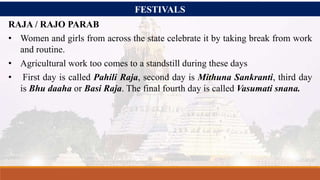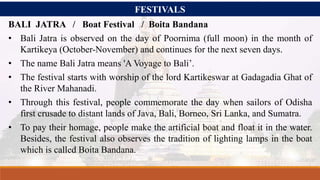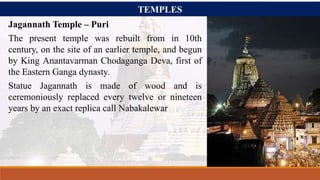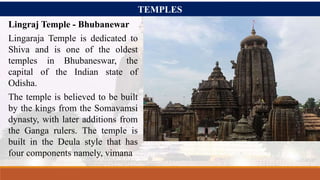Traditional Ethos of Odisha
- 1. Traditional Ethos of Odisha Gautam Kumar Assistant Professor University Department of Teacher Education Utkal University, Bhubaneswar, Odisha
- 2. Points of Discussion 1. Festivals 2. Art & Craft 3. Textile 4. Agriculture 5. Music and Dance 6. Temples a. Jagannath Temple – Puri b. Maa Tarini Temple – Ghatgaon, Keonjhar c. Sun Temple – Konark d. Lingraj Temple - Bhubanewar
- 3. Odisha – Land of Excellence in Art • Odisha also known as Utkal, which means the land of excellence in art. • The early history of Odisha can be traced back to the mentions found in ancient texts like the Mahabharata. • In 261 BCE, Ashoka of the Mauryan dynasty conquered the region in the bloody Kalinga War which was fought at the banks of River Daya near present- day Bhubaneswar. • In 261 BCE, Ashoka of the Mauryan dynasty conquered the region in the bloody Kalinga War which was fought at the banks of River Daya near present- day Bhubaneswar.
- 4. FESTIVALS
- 5. FESTIVALS RATHA YATRA • Ratha Yatra or Ratha Jatra or Chariot Festival of Lord Jagannath, Devi Subhadra and Lord Balabhadra. • Every year in the month of June or July, this festival is celebrated on the second day of the Shukla Paksha, Ashadh month as per the traditional Oriya calendar. • It is celebrated for nine days, the commencement of this festival is called as the Rath Yatra and the return journey on a ninth day is called as Bahuda Jatra. During the return journey (Bahuda Jatra) of Ratha yatra festival, the chariot of Lord Jagannath stops at Mausi Maa temple (Lord Jagannath's Aunt). • Lord Jagannath's Chariot is called as Nandighosa which is 45.6 feet high with 18 wheels, Lord Balabhadra's chariot is called as Taladhwaja which is 45 feet high with 16 wheels and Devi Subhadra's chariot is called as Dwarapadalan, which is 44.6 feet high with 14 wheels.
- 6. FESTIVALS
- 7. FESTIVALS RAJA / RAJO PARAB • Though the country still struggles with taboos related to menstruation, the Odisha celebrates 3-day long festival of menstruation and womanhood. • According to myths, during these three days of the Raja festival Mother Earth (the divine wife of Lord Vishnu) or Bhudevi undergoes menstruation. On the fourth day ceremonial bath (Vasumati Snana) takes place. • The term Raja came from the Sanskrit word 'Rajas' which means menstruation and when a woman menstruates, she is called 'Rajaswala' or a menstruating woman. • It is also called Mithuna Sankranti, which means the beginning of the Mithuna month, it signifies the first showers in the state which readies the soil for productivity.
- 8. FESTIVALS RAJA / RAJO PARAB • Women and girls from across the state celebrate it by taking break from work and routine. • Agricultural work too comes to a standstill during these days • First day is called Pahili Raja, second day is Mithuna Sankranti, third day is Bhu daaha or Basi Raja. The final fourth day is called Vasumati snana.
- 10. FESTIVALS BALI JATRA / Boat Festival / Boita Bandana • Bali Jatra is observed on the day of Poornima (full moon) in the month of Kartikeya (October-November) and continues for the next seven days. • The name Bali Jatra means 'A Voyage to Bali’. • The festival starts with worship of the lord Kartikeswar at Gadagadia Ghat of the River Mahanadi. • Through this festival, people commemorate the day when sailors of Odisha first crusade to distant lands of Java, Bali, Borneo, Sri Lanka, and Sumatra. • To pay their homage, people make the artificial boat and float it in the water. Besides, the festival also observes the tradition of lighting lamps in the boat which is called Boita Bandana.
- 11. ART & CRAFT ART & CRAFT • Odisha also known as Utkal, which means the land of excellence in art. • Odisha is a treasure trove of wonderful handicraft and traditional art forms, a rich legacy of an ancient culture. • The appliqué works of Pipili or Pattachitras, silver filigree jewellery and golden grass mats of Cuttack, Ikkat saree of Cuttack and Sambalpur, Dhokra and clay toys of Mayurbhanj and Barapali, Lacquer work of Nawangapur, Horn work of Parlakhemundi, flexible brass fish of Ganjam. Each handicraft exudes a charm and originality of its own and pristine beauty that remained untouched by time. The beauty and charm of Orissi handicraft mirrors a heritage in its past and present flowing into eternity.
- 12. ART & CRAFT Patta Chitra -Raghurajpur, Puri
- 13. ART & CRAFT Horn Work
- 14. ART & CRAFT Palm Leaf Drawing
- 15. ART & CRAFT Tasar Patta
- 17. ART & CRAFT Applique Work -Pipli
- 18. ART & CRAFT Silver Filigree Work -Cuttack (Silver City)
- 19. ART & CRAFT Sand Art -Sudarshan Pattanaik
- 20. TEXTILE
- 21. TEXTILE • Kotpad –Koraput • Sambalpuri Silk – Sambal Puri • Habaspuri – Kalahandi • Pasapali or Saktapar – Bargarh • Dongria - Rayagada and Kalahandi • Bomkai / Sonepuri • Berhampuri - Berhampur
- 22. Music and Dance Music • Odissi music is a classical style of music that comprises all the essential elements, such as talas and ragas, common to Karnatic and Hindustani Music. • Jayadeva was the first Odia poet to compose musical lyrics that were meant to be sung and he also suggested the classical ragas existing during that time in which the lyrics were to be sung. • Odissi sangita is a combination of four classes of music chitrakala, chitrapada, dhruvapada and panchal. The main ragas in Odissi sangita are Bhairavee, Baradi, Dhanashri, Kalyana, Karnata, Nata, Panchama, Shree Gowda and Shokabaradi.
- 23. Music and Dance ODISSI DANCE Renowned as the most revered classical dance form in Odisha, Odissi Dance is a typical dance form where religious and mythical stories and poems emoted by the dancers through expressions, body movements, and gestures.
- 24. Music and Dance MEDHA NACHA Medha Nacha is a type of mask dance performed mainly in the coastal districts of Odisha. Oversized masks of kings, queens, and devils made by paper pulp are used by dancers to perform this beautiful dance form in India.
- 25. Music and Dance DANDA NATA One of the most popular folk dances of Odisha performed in the Ganjam district is Danda Nata. In this form of dance, devotees undergo a penance to appease Lord Shiva by physically touring their body.
- 26. Music and Dance CHAITI GHODA Chaiti Ghoda dance, also known as the Horse Dance is mainly performed during the festivities related to the fishing communities of Odisha. This interesting-to- watch dance form is only performed by Kaibarta Caste.
- 27. Music and Dance SAMBALPURI DANCE Sambalpuri Dance is the Most famous Folk Dance of Western Odisha. The Sambalpuri folk dance originated from the vibrant Sambalpur district in which the performers sing Dalkhai to the beats of Timkis, Drums and Nisans
- 28. TEMPLES Jagannath Temple – Puri The present temple was rebuilt from in 10th century, on the site of an earlier temple, and begun by King Anantavarman Chodaganga Deva, first of the Eastern Ganga dynasty. Statue Jagannath is made of wood and is ceremoniously replaced every twelve or nineteen years by an exact replica call Nabakalewar
- 29. TEMPLES Maa Tarini is one of the embodiments of Shakti and is one of the chief presiding Goddesses in Odia culture. Her chief shrine is in Ghatgaon, Keonjhar District, Odisha.
- 30. TEMPLES KONAKR SUN TEMPLE Konark sun temple is 13th-century CE Sun temple at Konark on the coastline of Odisha, India. The temple is attributed to king Narasimhadev-I of the Eastern Ganga Dynasty about 1250 CE. temple complex has the appearance of a 100-foot (30 m) high chariot with immense wheels and horses, all carved from stone. Once over 200 feet (61 m) high.
- 31. TEMPLES Lingraj Temple - Bhubanewar Lingaraja Temple is dedicated to Shiva and is one of the oldest temples in Bhubaneswar, the capital of the Indian state of Odisha. The temple is believed to be built by the kings from the Somavamsi dynasty, with later additions from the Ganga rulers. The temple is built in the Deula style that has four components namely, vimana
- 32. Saturday, 08 August 2020 GAUTAM I UUDTE I UTKAL UNIVERSITY 32 Thank You !
































